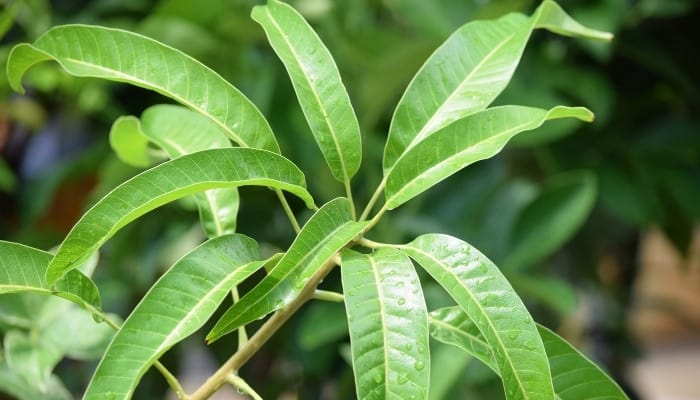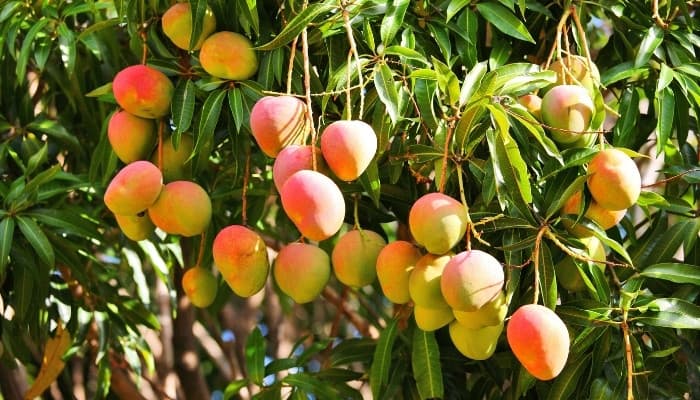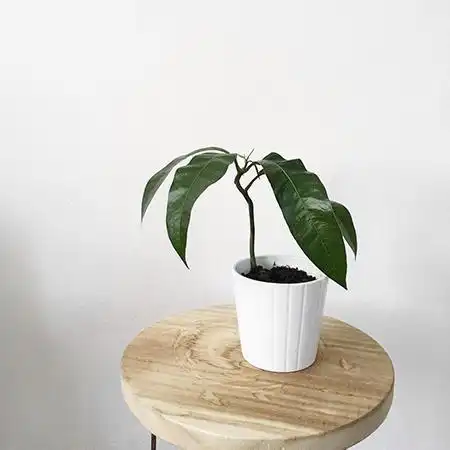Mango trees are one of the most exotic types of indoor fruit trees, and unlike many other tropical plants, they are relatively easy to cultivate and maintain.
Can you grow a mango tree indoors? Mango trees can grow indoors with the right care. Start with a healthy seedling or sprout your own from a seed. Pot in a mix of clay, loam, and sand, and provide 8-10 hours of light daily. Thoroughly water when dry, and fertilize every 3-4 months. Mango trees need high humidity and air flow.
Not everyone is up for the challenge of growing a mango tree indoors, but if you’re committed to providing the perfect environment, it can be a rewarding endeavor.
We’ll show you what you need to succeed below.
How To Grow a Mango Tree Indoors
Mango trees aren’t harder to grow than most plants; in fact, they are easier to grow than some.
Select Your Tree or Sprout a Mango Seed
The first real step to growing a mango tree indoors is selecting your tree or getting your hands on a seed and sprouting it into a seedling.
There are well over 1,000 species of mango trees with several hundred produced commercially. Below, we highlight several of the most preferred varieties.
But first, let’s discuss how to germinate a mango tree from a seed.
In case you don’t want to purchase a mango tree, you can easily start one from a seed.
All you need to do is remove the seed from the husk, soak it in a glass of water for a full day, and then store it in a moist paper towel until it sprouts.
If you store the seed and moist paper towel somewhere warm and don’t let it dry out, you’ll have a sprouting mango tree within days to weeks.
Once the sprout begins to grow and pushes away from the seed, carefully plant it in a pot with moist potting soil.
Best Mango Trees for Growing Indoors
- Carabao – A mango species from the Philippines, the Carabao mango is also known as the Manila mango. It is the national fruit of the Philippines. It is sweet, juicy, and less stringy than other mangos.
- Dasheri – A sweet and aromatic peach-colored mango with very little fiber is the Dasheri. Hailing from India, it has a yellowish green skin when it’s ripe, which is typically in late summer.
- Kent – The Kent species is another sweet, juicy mango with a hint of sourness; many growers compare it to a tropical peach. Kent mangos originate from Ecuador, Mexico, and Peru.
- Langra – One of the most famous mango species there is, Langra mangos belong to the Varanasi variety. They are juicy, sweet, and somewhat sour or tart at the same time and rich in fiver.
Get a jump-start with a 1-2-foot or 3-4-foot starter mango tree, shipped right to you! Nice selection of mango trees and great customer service.
Potting a Mango Tree
Spring time is the traditional time of the year to pot mango trees. Prepare a soil mix that is quick to drain and easily saturated.
Clay, loam, and sand are the most preferred ingredients for potting mango trees.
If you’re starting from a seedling, plant your mango a small pot. Otherwise, decide the size of the pot by measuring the root ball.
The pot should be just big enough to hold the root ball and allow it to slightly expand over the next year or so.
To increase the drainability of your tree, you may also consider adding an inch or so of gravel into the bottom of your pot before adding the first layer of soil.
Once the pot is 1/3 of the way full, plant the tree with the root ball spread open as wide as possible.
It is best practice to repot your mango tree every 12 to 24 months. If not, it may become rootbound and more or less stay dormant.
A happy tree is a tree with plenty of room for its roots to expand.
Lighting Needs for an Indoor Mango Tree
Mango trees prefer quite a bit of sun compared to many other houseplants. They require around 8 to 10 hours of sunlight each day.
Westward and south-facing windows provide the most readily available bright light.
However, even if you have windows that get quite a bit of bright light, your mango tree may still want or need a bit of direct sunlight.
For that reason, it is best practice to take the pot outside and into the full sun as often as possible.
Watering & Fertilizing an Indoor Mango Tree
Mango trees react best to watering directly above their root zone and along their taproot.
Depending on the state of your tree’s soil, wait for a minute or two for the water to penetrate the root zone, and then add more water.
Aim for at least the top several inches of soil to be moist.
Your mango tree also requires fertilization once every 3 to 4 months.
Depending on the state of the tree, the health of the soil, and other factors, you may not need to fertilize more than twice per year.
Pruning an Indoor Mango Tree

There are two main reasons for pruning an indoor mango tree. The first and main reason people prune their mango trees is to keep them generally maintained and well shaped.
The second reason for pruning mango trees is to keep them smaller than they are naturally.
Use sharp, clean hand pruners to remove broken, dead, or dying branches.
That way the tree can preserve energy and focus on new and healthy growth rather than waste it on dead or dying parts.
If you want to keep your mango tree smaller, simply snip the tops of the tree off, and it will tend to grow sideways rather than up.
If the tree does begin branching upward, prune the top again.
Will an Indoor Mango Tree Bear Fruit?
If you want your mango tree to bear fruit indoors, you need to take good care of it.
First and foremost, your tree must be situated somewhere that it receives at least 8 hours of light each day.
In addition, you must mind the tree’s temperature and humidity level, keep the soil moist, fertilize it, and mist the leaves on a regular basis.
A happy and healthy mango tree produces fruit regardless of whether it is indoors or outdoors.
How Long Does It Take for a Mango Tree To Bear Fruit?
Mango trees take 3 to 5 years to become thriving specimens, but in many cases, especially indoors, they may take an additional 2 to 3 years to start producing plenty of fruit each year.
Related Questions:
How Long Do Mango Trees Live?
Mango trees may live for well over 100 years if they are cared for properly. Under the right conditions, mango trees may live (and produce fruit) for over 300 years.
Are Mango Trees Toxic to Pets?
Mango trees, including the fruit, are nontoxic to pets.
The only danger that mangos themselves present to pets is the same threat they pose to humans: the seed is large enough to block airways and cause choking if ingested.
A Final Word About Growing and Caring for Mango Trees
Mango trees not only grow well indoors and eventually produce fruit, but they are relatively easy to care for as well.
That said, if you plan on planting and growing one from a seed, you’ll need a green thumb and plenty of patience before you ever get to pluck that first ripe mango from your tree.
Will it be worth the wait? Absolutely!


